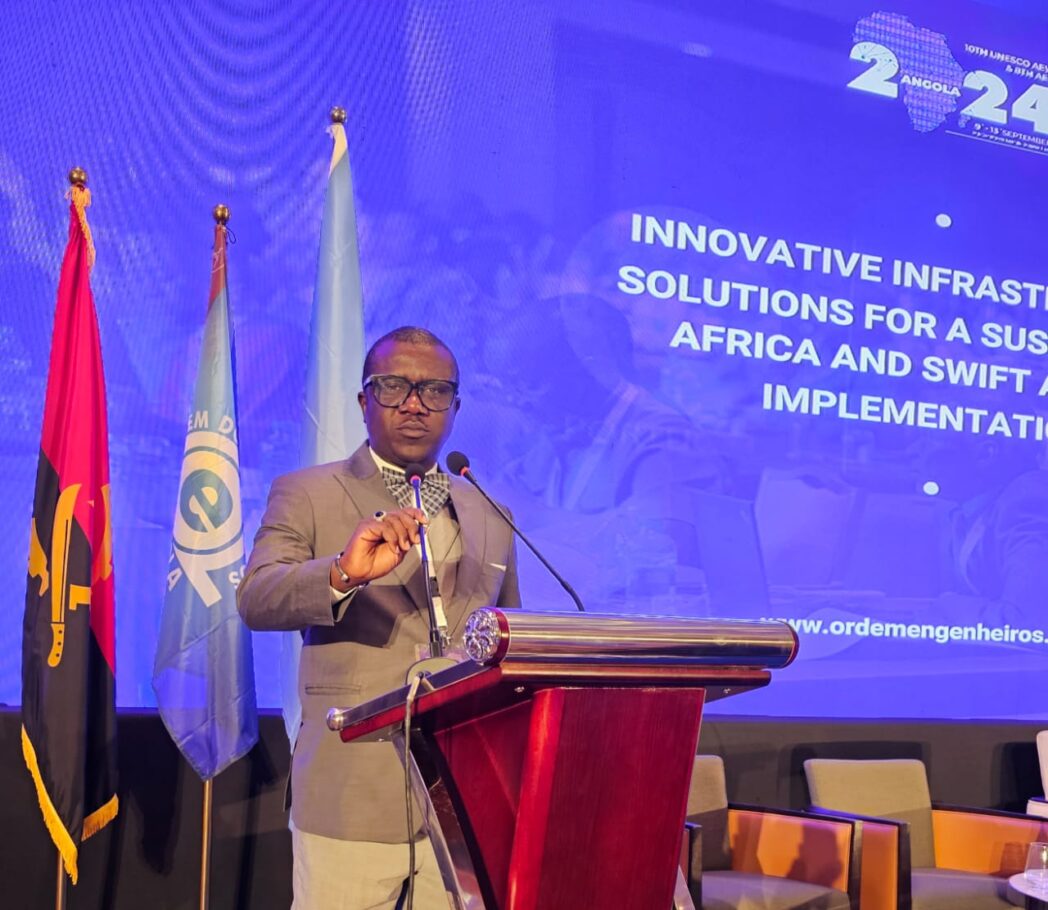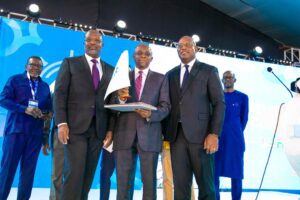


“Integrating Design Thinking, Problem-Solving Skills into Engineering Curriculum Way Forward” – Dr. Mudasiru
“Integrating Design Thinking, Problem-Solving Skills into Engineering Curriculum Way Forward” – Dr. Mudasiru
By Matthew Denis, Abuja
Dr. Mudasiru Bola, the National Secretary General of the Nigerian Institution of Highway and Transportation Engineers (NIHTE) has stated that in engineering, “Technology, People, and Delivery” refers to the three key elements that are crucial for successful project outcomes which is better described as the engineering hat trick to become a unicorn engineer in the profession.
Speaking on a topic: Innovative Leadership in Engineering, A Tool for Reforming Engineering Education at the ongoing 10th UNESCO African Week and 8th African Engineering Conference in Luanda, Angola, “the expert proposes a curricular reform in African engineering education, incorporating design thinking, problem-solving, and other cutting-edge approaches to foster a culture of innovation, entrepreneurship, and interdisciplinary collaboration, consistent with the UNESCO Engineering Education Framework and the IEA (International Engineering Alliance) Graduate Attributes.”
Breaking down his presentation, Dr. Mudasiru explained that Technology encompasses the tools, software, hardware, and systems used to design, develop, and deliver engineering projects. This includes cutting-edge innovations, technical expertise, and digital solutions.
“He noted that technology encompasses a broad spectrum of elements, including architectural frameworks, solutions, designs, and innovation, all of which are spearheaded by our leadership team.”
“In engineering projects, the human factor is a critical component, involving the strategic management of team resources, expertise, and synergies, while also considering stakeholders’ interests, expectations, and communication needs. This requires effective leadership, management, and organizational culture to facilitate collaboration, communication, and stakeholder satisfaction, ultimately driving project outcomes and success.”
“People leadership is about empowering others through mentorship, coaching, and replication of expertise. By sharing my experiences and insights with others, I have not only developed their capabilities but also received valuable input and perspectives in return. This symbiotic approach to leadership promotes a culture of continuous learning, collaboration, and knowledge sharing, ultimately driving collective growth and success.”
While delivering focuses on the planning, processes, methods, control and timelines that ensure projects are completed efficiently and effectively within the budget..
He argued that, there is this temptation of over-indexing in one or the other area of Engineering Leadership. Noting that under engineering hat trick, we have Technology Leadership, Delivery Leadership and People Leadership. In a venn diagram when you merge technical and people you will become a visionary, that’s a leader with the people and technical skills and you are someone who knows what goods looks like from a tech perspective and get the people rallying around it but when you are in between a tech and process you’re just a leader who knows how to execute a tech strategy with the highest quality and efficiency but such a leader will have issues with team engagement.
But if you’re in between the people and delivery you are an adaptive leader who can manage people very well and get the process done perfectly but the tech aspect is not there.
“When we talk about the hat trick of engineering leadership just like some of us that watch football every player will like to score hat trick. So every leader managing engineering team is to have what we called the hat trick of engineering leadership which has to do with Technology leadership, Business leadership and people leadership.
The expert revealed that the dream of every engineering leader is the ability to manage the technical, people and delivery aspect of every project and that makes such an engineer a Unicorn.
“I can say the current president of Nigeria society of Engineers (NSE), Engr. Margaret Aina Oguntala FNSE is a unicorn of our society because in a short while she is being able to manage the technical part of the society, the people and delivery angles too. As an engineer you can manage these elements together and be refer to as a unicorn leader.
Fortunately, balancing and integrating these three elements is essential for engineering projects to succeed and deliver value to customers, stakeholders, and society.
“He advocates for a harmonized approach to engineering leadership, where professionals and government entities converge to harness their collective strength, expertise, and political influence to execute policies and drive meaningful change in Africa’s education sector. This synergy is crucial for unlocking the sector’s potential and driving sustainable progress.”
“According to him, professional bodies such as the Nigerian Society of Engineers (NSE) and the Council for the Regulation of Engineering in Nigeria (COREN) are making commendable efforts to revitalize education in the sector. A key focus area is the provision of industrial-based training for graduates, with a proposed one-year field training program aimed at exposing students to practical scenarios, thereby bridging the gap between academic knowledge and industry experience.”
“He stressed that a country-specific model is essential for effective educational reform in Africa. In Nigeria’s case, a tiered engineering workforce requires a customized training framework. The Nigerian Society of Engineers, under its current leadership, is implementing programs designed to introduce junior engineers to emerging technologies, such as IT, tech, and startup innovation, thereby bridging the skills gap and enhancing the profession’s overall competitiveness.”
“For executives and senior professionals, training programs are designed to enhance leadership capabilities, smart farming techniques, and other high-level skills. Furthermore, the NSE’s structured workshops, supported by the current administration, aim to upskill engineers and empower them to drive positive impact in their communities and the broader society.”
“Thus, a country-specific approach to educational reform is crucial, taking into account the unique context and needs of each nation. I was impressed to learn that in Angola, for instance, the Project Management Institute (PMI) is spearheading an initiative to develop 1,000 project managers, demonstrating a strategic effort to reform education. To achieve meaningful reform, a collaborative effort between academia, government, and policymakers is essential. Moreover, government leaders must demonstrate the necessary political will to drive policy changes, as without this commitment, discussions on reform will remain inconsequential.”
“It is imperative that we engage with government stakeholders and present a unified vision for educational reform, outlining our objectives and strategies for revitalizing the sector. By securing government support and buy-in, we can empower students to become globally competitive engineers, equipped to thrive in an increasingly interconnected world. This, in turn, will enable them to seamlessly transfer knowledge and expertise across borders, from Angola to Chad, Nigeria, Europe, and beyond, fostering a culture of collaboration and innovation.”
“He highlighted the importance of fostering a culture of innovation and entrepreneurship in education, stressing that these elements are crucial for driving progress. ‘Innovation encourages adaptability and creative problem-solving, allowing us to think beyond conventional boundaries,’ he noted. Citing a recent news report, he illustrated this point by referencing India’s efforts to revolutionize traditional construction methods by adopting innovative steel bridge designs, particularly in coastal areas. This example demonstrates how embracing innovation can lead to more efficient and effective solutions.”
“He stressed that engineering is a challenging field that requires innovative thinking. To develop effective leadership in Africa, we must reform our education system to focus on solving real-world problems. This will enable us to produce engineers who can drive meaningful change and progress.”
“It is essential that we promote entrepreneurship programs by offering mentorship opportunities, such as those provided by the Nigerian Society of Engineers (NSE). Our tiered mentorship structure, comprising senior, middle, and junior engineers, enables knowledge transfer and skill development. Senior engineers are expected to guide and train junior engineers, while executive engineers mentor middle-level professionals. This mentorship framework should be encouraged and supported to reform education. Furthermore, establishing circuit incubators that provide resources and facilities for mentorship will help foster innovation and entrepreneurship.”
In the aspect of business, he stated that if you’re a petrochemicals engineer you have to look at the business angle of your field, and as a mentor you have to train your mentees on the business angle of your profession. That is what we call business engineering where we look at profit and loss of a company, profitability of your engineering process or project and maximize that to have a good ROI in the project. These are some of the skills that when we talk of innovation it’s very much important.
Another important thing has to do with people’s skills when you invest in the growth of your team you are unlocking the potential in them. While some leaders may excel in one or two areas true engineering leadership requires proficiency in these three areas we are talking about people, technology and business.
“The expert recommends that the way forward involves transforming engineering education by embedding design thinking and problem-solving skills into the curriculum. This strategic integration will foster a more holistic and innovative learning experience, empowering students to develop creative solutions and address intricate engineering problems.”
“He emphasized the importance of fostering a culture of innovation among engineering students, encouraging them to think creatively, pacify complex problems, and develop prototype solutions through design thinking and problem-solving. Furthermore, he advocated for promoting interdisciplinary collaboration in engineering education, which involves breaking down silos and facilitating cross-disciplinary projects that span multiple engineering disciplines. This approach enables students to work together, share knowledge, and develop a holistic understanding of complex engineering challenges.”



